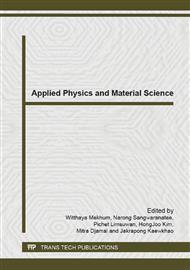p.405
p.409
p.413
p.417
p.421
p.426
p.431
p.435
p.440
The Study of Cook-Stove Thermoelectric Generator Power
Abstract:
This research studies the alternative way of electricity generating from the waste heat of economy oven by using 4 modules of thermoelectric modules. The hot side of thermoelectric module is attached to the heat plate while the cold side is installed on the rectangular, plate-fin heat exchanger. Variety of system adjustments were used during this study in terms of finding the maximum electric power rate. Adjusting the heating value and the electrical resistance to the thermoelectric was the procedure in this study. From the research, we found out that at the temperature of 200°C on the heat pad, the released maximum electric current was 4.5 W. The percentage of heat converting to electric current was 11.9%, with the 0.84 A and 5.35 V. The efficiency of the economy oven was 23.20%, and comes up to 23.39% while generating power via thermoelectric module.
Info:
Periodical:
Pages:
421-425
Citation:
Online since:
June 2014
Authors:
Keywords:
Price:
Сopyright:
© 2014 Trans Tech Publications Ltd. All Rights Reserved
Share:
Citation:


